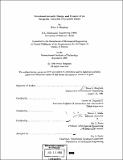Structural-acoustic design and control of an integrally actuated composite panel
Author(s)
Bingham, Brian S. (Brian Steven), 1973-
DownloadFull printable version (72.95Mb)
Advisor
Nesbit W. Hagood, IV.
Terms of use
Metadata
Show full item recordAbstract
The need for structural based acoustic control is evident in aircraft, aerospace, and naval systems. A promising approach utilizes active materials to intelligently control the dynamic response of light-weight, modally dense structures suppressing the radiated acoustic power. The basic representative structural element of a single panel offers an analytically tractable basis for examining various control methodologies for mitigating the acoustic response. An electro-mechanical Rayleigh-Ritz structural model is combined with an expression of the acoustic power radiated from a rectangular panel to yield a fully coupled structural-acoustic model. The insight afforded by this model is used to design the sensor and actuator architecture of the active structure for optimal closed-loop acoustic performance. The manufacturing of a composite panel with eight embedded active fiber composite (AFC) actuators and collocated strain sensors is presented in detail. The geometry of the test article is designed to represent the dynamics of the target applications, and the active elements are embedded in the composite panel to demonstrate the capabilities of the technology. Active control methods are explored through simulations and experiments to compare the applicability to active structural-acoustic control (ASAC). To quantify the comparison, designs based on classical low-authority feedback, optimal feedback, and x-filtered LMS feedforward techniques are presented. The results lend insight into the inherent limitations and advantages of each approach to the problem of broadband control. The investigation is application motivated in that the sensing and piezoelectric actuation occur solely at the structure while the performance is measured in the acoustic field. The conclusions consider the analytically predicted performance along with the corresponding experimental achievement to develop an understanding of the key issues necessary to apply the technology to the active structural-acoustic control of complex systems.
Description
Thesis (S.M.)--Massachusetts Institute of Technology, Dept. of Mechanical Engineering, 1998. Includes bibliographical references (p. 165-170).
Date issued
1998Department
Massachusetts Institute of Technology. Department of Mechanical EngineeringPublisher
Massachusetts Institute of Technology
Keywords
Mechanical Engineering